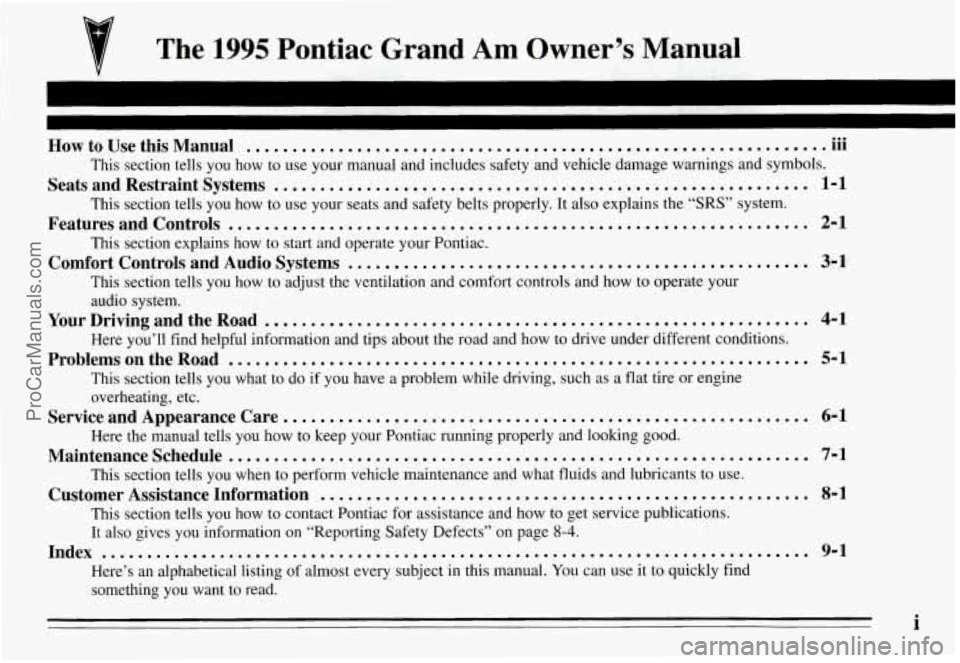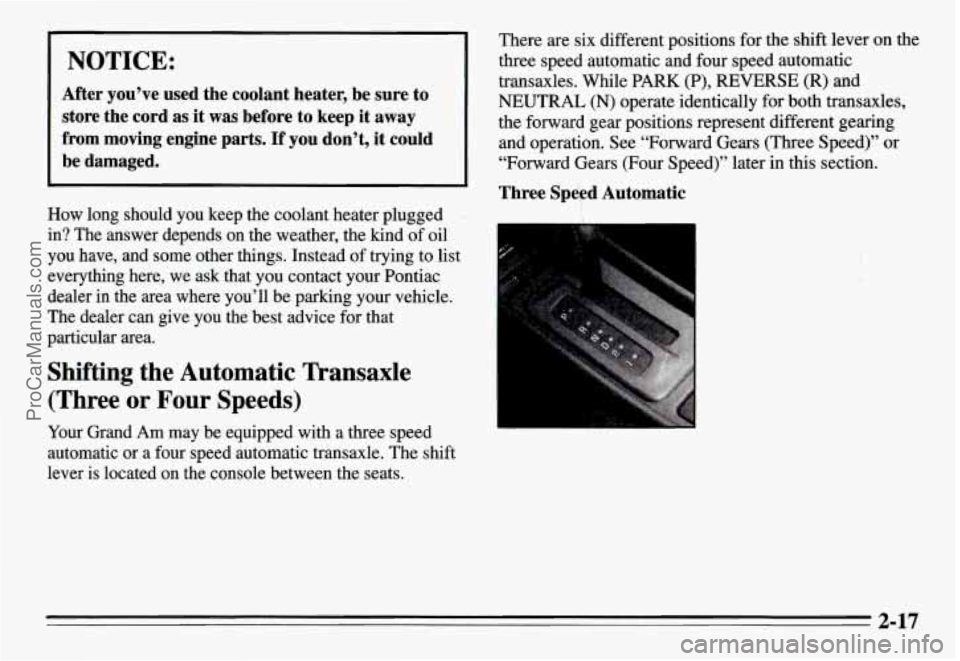1995 PONTIAC GRAND-AM engine
[x] Cancel search: enginePage 2 of 354

v The 1995 Pontiac Grand Am Owner’s Manual
... How to Use this Manual .............................................................. .111
Seats and Restraint Systems .......................................................... 1-1
Features and Controls ............................................................... 2-1
Comfort Controls and Audio Systems .................................................. 3-1
This section tells you how to use your manual and includes safety and vehicle damage warnings and symbols.
This section tells you how to use your seats and safety belts properly. It also explains the “SRS” system.
This section explains how to start and operate your Pontiac.
This section tells you how to adjust the ventilation and comfo\
rt controls and how to operate your
audio system.
Here you’ll find helpful information and tips about the road\
and how
to drive under different conditions.
This section tells you what to do
if you have a problem while driving, such as a flat tire or engine
overheating, etc.
Here the manual tells you how to keep your Pontiac running properly and looking good.
This section tells you when to perform vehicle maintenance and what fluids and lubricants to use.
This section tells you how to contact Pontiac for assistance and how to get service publications.
It also gives you information on “Reporting Safety Defects” on page 8-4.
Here’s an alphabetical listing of almost every subject in this manual. You can use it to quickly find
something you want to read.
YourDrivingandtheRoad ........................................................... 4-1
ProblemsontheRoad ............................................................... 5-1
Service and Appearance Care. ........................................................ 6-1
Maintenanceschedule ............................................................... 7-1
Customer Assistance Information ..................................................... 8-1
Index ........................................................................\
..... 9-1
i
ProCarManuals.com
Page 6 of 354

Vehicle Symbols
These are some of the symbols you may find on your vehicle.
For example,
these symbols
are used on an
original battery:
POSSIBLE A
CAUTION
INJURY
PROTECT EYES BY
SHIELDING
CAUSTIC
BURNS
SPARK OR ,\I/,
COULD FLAME
EXPLODE BATTERY
These symbols are important
for you and
your passengers
whenever your
vehicle
is
driven:
DOOR LOCK
UNLOCK
FASTEN SEAT 4
BELTS
POWER
WINDOW
These symbols
have to do with
your lights:
SIGNALS e 9
TURN
WARNING A
HAZARD
FLASHER
FOG LAMPS $0
These symbols
are on some
of
your controls:
WINDSHIELD
WIPER
WINDSHIELD
DEFROSTER
WINDOW
DEFOGGER
VENTILATING FAN
These symbols are used on
warning and
indicator lights:
COOLANT Fe
TEMP --
ENGINE
CHARGING I-1
BATTERY
SYSTEM
BRAKE (a)
RADIATOR COOLANT
FUEL
ENGINE OIL
PRESSURE
Wb
TEMP OIL &
ANTI-LOCK (@)
BRAKE
Here are some
other symbols
you may see:
FUSE
RELEASE
RADIO
VOLUME
CONDITIONING A‘R 43
RELEASE
LIGHTER m
HORN )tr
SPEAKER
b
V
ProCarManuals.com
Page 67 of 354

LOCK (B): This is the only only position in which you
can remove the key. This locks your steering wheel,
ignition and transaxle (on automatic models).
OFF (C): This unlocks the steering wheel, ignition, and
transaxle (on automatic models), but does not send
electrical power to any accessories. Use this position
if
your vehicle must be pushed or towed, but never try to
push-start your vehicle.
A warning chime will sound if
you open the driver’s door when the ignition is
off and
the key is in the ignition.
RUN (D): This is an “on” position to which the switch
returns after you start your engine and release the
switch. The switch stays in the RUN position when the
engine
is running. But even when the engine is not
running, you can use RUN to operate your electrical
power accessories, and to display some instrument panel
warning lights.
START (E): Use this for starting the engine. When the
engine starts, release the key. The ignition switch will
return to RUN for normal driving.
Note that even if the engine is not running, the positions
ACCESSORY and RUN are ON positions that allow
you to operate your electrical accessories, such as the
radio.
Key Release Button (Manual Transaxle)
The key cannot be removed from the ignition unless the
key release button is used.
To remove the key turn the key to the OFF position.
Press the key release button while turning the key from
OFF to LOCK. Keeping your finger on the button, pull
the key straight out.
2-12
ProCarManuals.com
Page 68 of 354

I NOTICE:
If your key seems stuck in LOCK and you can’t
turn it, be sure it is all the
way in. If it is, then
turn the steering wheel left and right while you
turn the key hard. But turn the key only with
your hand. Using
a tool to force it could break
the key or the ignition switch.
If none of this
works, then your vehicle needs service.
Starting Your Engine
Engines start differently. The 8th digit of your Vehicle
Identification Number (VIN) shows the code letter or
number for your engine.
You will find the VIN at the top
left of your instrument panel. (See “Vehicle
Identification Number” in the Index.) Follow the proper
steps to start the engine.
Automatic transaxle:
Move your shift lever to PARK (P) or NEUTRAL (N).
Your engine won’t start in any other position
-- that’s a
safety feature.
To restart when you’re already moving,
use NEUTRAL (N) only.
NOTICE:
Don’t try to shift to PARK (P) if your Pontiac is
moving. If you do, you could damage the
transaxle. Shift to PARK
(P) only when your
vehicle
is stopped.
2-13
ProCarManuals.com
Page 69 of 354

Manual transaxle:
The gear selector should be in neutral. Hold the clutch
pedal to the floor and
start the engine. Your vehicle
won’t start
if the clutch pedal is not all the way
down
-- that’s a safety feature.
To start your 2.3 Liter engine:
1. Without pushing the accelerator pedal, turn your
ignition key to START. When the engine starts, let
go of the key. The idle speed will go down as your
engine gets warm.
NOTICE:
Holding your key in START for longer than 15
seconds at a time will cause your battery to be
drained much sooner. And the excessive heat can
damage your starter motor.
I
2. If it doesn’t start right away, and if the weather is
very cold (below
-20” F, or -29” C), push the
accelerator pedal about one-quarter of the way down
while you turn the key to START.
Do this until the
engine starts. As soon as it does, let
go of the key.
3. If your engine still won’t start (or starts but then
stops), it could be flooded with too much gasoline.
Try pushing your accelerator pedal
all the way to the
floor and holding it there as you hold the key in
START for about three seconds.
This clears the extra
gasoline from the engine. If the car starts briefly but
then stops again, do the same thing, but this time
keep the pedal about one-quarter of
the way down
for five or six seconds.
NOTICE:
Your engine is designed to work with the
electronics in your vehicle.
If you add electrical
parts or accessories, you could change the
way
the fuel injection system operates. Before adding
electrical equipment, check with your dealer.
If
you don’t, your engine might not perform
properly.
If you ever have to have your vehicle towed, see
the part
of this manual that tells how to do it
without damaging your vehicle. See “Towing
Your Vehicle’’ in the Index.
2-14
ProCarManuals.com
Page 70 of 354

To start your 3.1 Liter engine:
1. Without pushing the accelerator pedal, turn your
ignition key to START. When the engine starts, let
go
of the key. The idle speed will go down as your
engine gets warm.
NOTICE:
Holding your key in START for longer than
15 seconds at a time will cause your battery to be
drained much sooner. And the excessive heat can
damage your starter motor.
2. If your engine won’t start (or starts but then stops), it
could be flooded with
too much gasoline. Try
pushing your accelerator pedal all the way to the
floor and holding
it there as you hold the key in
START for about three seconds.
If the car starts
briefly but then stops again, do the same thing, but
this time keep the pedal down for five or six seconds.
This clears the extra gasoline from the engine.
NOTICE:
Your engine is designed to work with the
electronics in your vehicle.
If you add electrical
parts or accessories, you could change the way
the fuel injection system operates. Before adding
electrical equipment, check with your dealer.
If
you don’t, your engine might not perform
properly.
If you ever have to have your vehicle towed, see
the part of this manual that tells how to do
it
without damaging your vehicle. See “Towing
Your Vehicle” in the Index.
2-15
ProCarManuals.com
Page 71 of 354

Driving Through Deep Standing Water To use the coolant heater:
1. Turn off the engine.
2. Open the hood and unwrap the electrical cord.
NOTICE: 3. Plug it into a normal, grounded 110-volt outlet.
If you drive too quickly through deep puddles or
standing water, water can come in through your
engine's air intake and badly damage your engine.
If you can't avoid deep puddles or
standing water, drive through them very slowly.
Engine Coolant Heater (Option)
In very cold weather, 0" F (- 18 O C) or colder, the engine
coolant heater can help. You'll get easier starting and
better fuel economy during engine warm-up. Usually,
the coolant heater should be plugged in a minimum of
four hours prior to starting your vehicle.
2-16
ProCarManuals.com
Page 72 of 354

I NOTICE: I
After you’ve used the coolant heater, be sure to
store the cord as it was before to keep it away
from moving engine parts.
If you don’t, it could
be damaged.
How long should you keep the coolant heater plugged
in? The answer depends on the weather, the kind of oil
you have, and some other things. Instead of trying to list
everything here, we ask that you contact your Pontiac
dealer
in the area where you’ll be parking your vehicle.
The dealer can give you the best advice for that
particular area.
Shifting the Automatic Transaxle
(Three or Four Speeds)
Your Grand Am may be equipped with a three speed
automatic or a four speed automatic transaxle. The shift
lever
is located on the console between the seats.
There are six different positions for the shift lever on the
three speed automatic and four speed automatic
transaxles. While
PARK (P), REVERSE (R) and
NEUTRAL (N) operate identically for both transaxles,
the forward gear positions represent different gearing
and operation. See “Forward Gears (Three Speed)” or
“Forward Gears (Four Speed)’’ later in this section.
Three SpeFd Automatic
1.
.. . ..b
2-17
ProCarManuals.com